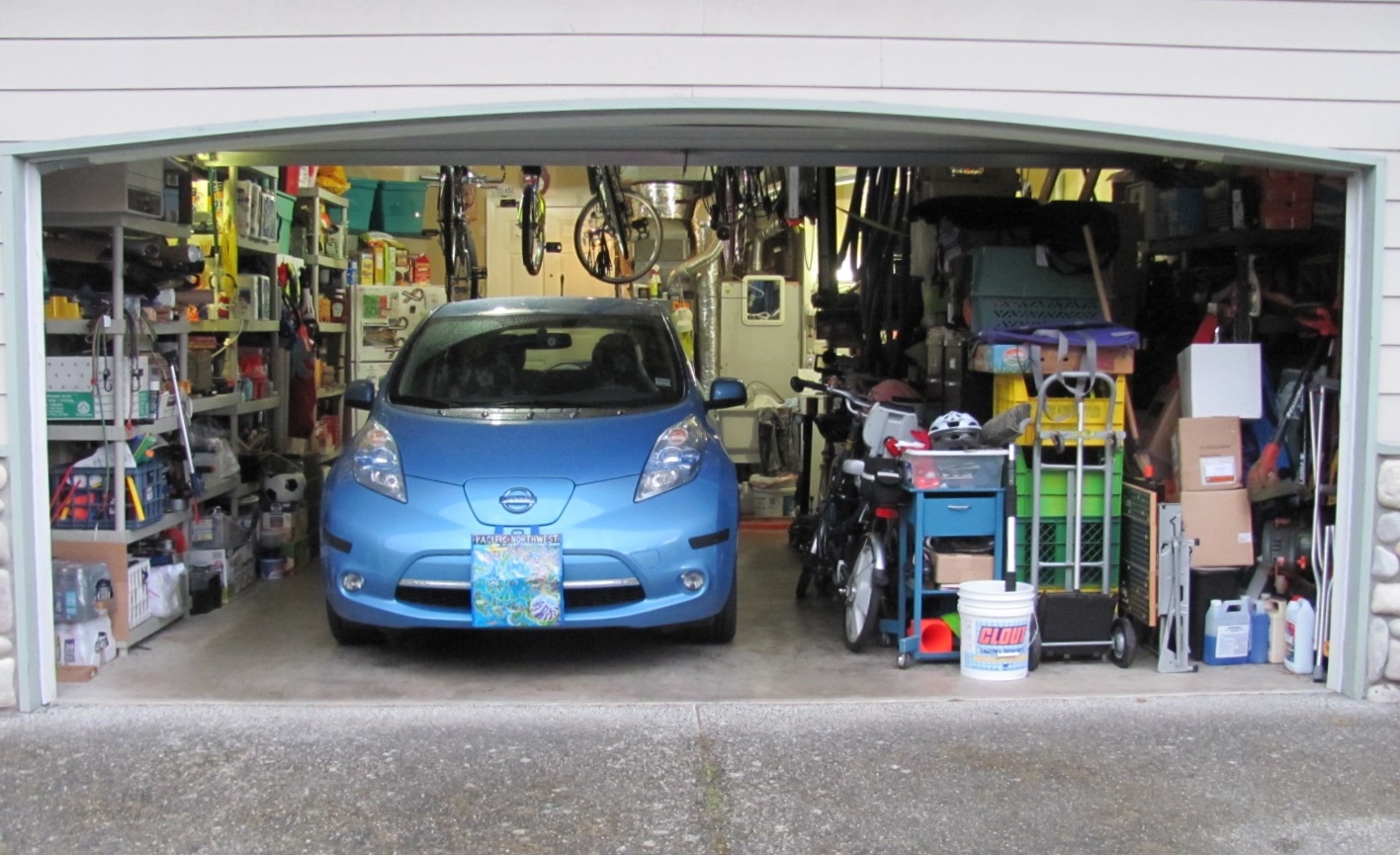This is part 1 of a Sightline series on parking requirements. Read parts 2, 3, and 4.
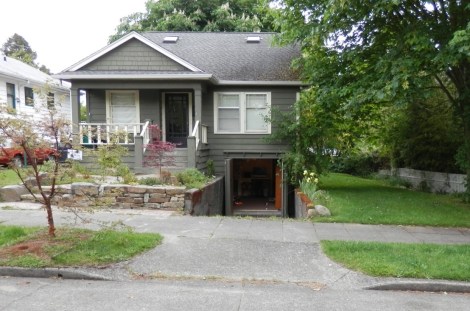
Alan Durning
I have not owned a car in seven years, but I do own a garage. It’s pictured above. In fact, I am legally required to own an off-street parking space; that’s written in the land-use code for my city, Seattle, as for virtually every city. The driveway that leads to my garage, meanwhile, eliminates almost exactly one parking space from my street. Parking in front of a driveway is illegal, and a regular curb cut is almost exactly the size of a parking space, as illustrated below.
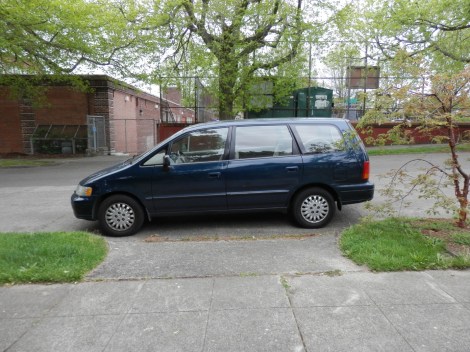
Alan Durning
The net effect — one mandatory off-street parking space plus one car-less household — is a one-space reduction of parking supply on my block. Repeat: My obligatory driveway and garage deprive the universe of one on-street slot. This is ironic, but it’s only the tip of the irony iceberg where car-storage is concerned.
If I did own a car to keep in my garage, the net effect would no longer be a net reduction. It would be zero. My driveway subtracts one on-street space; my garage adds it back. Think about that for a while. The 4.6 million single-family houses in cities across the Northwest, and tens of millions more across the U.S., are each required to have at least one off-street parking space. Yet many of these city rules add no net parking spaces to their cities’ supplies. Worse, if you’ve ever narrowly escaped a car backing out of a garage, or almost backed into someone while you were driving, you can quickly grasp the fact that all these millions of mandated off-street parking spaces turn sidewalks into danger zones, especially for children and the disabled.
Clearly, parking rules can lead to absurd and unwelcome results. In fact, I will argue in this new series, they have surprisingly pernicious effects not just in single-family homes but across entire cities. Requirements that builders provide ample quotas of off-street parking spaces worsen traffic, multiply collisions, push up housing prices, dampen business profitability, amplify sprawl, and pollute both air and water. Parking rules are a surprisingly potent hidden force shaping — or misshaping — our communities. Fortunately, new approaches and new technologies allow better ways to manage parking, and these better ways turn out to be among the biggest opportunities open to cities for improving residents’ lives.
I’ll get to all of that soon. I promise. But let’s go back to my garage. Understanding how off-street parking rules for single-family houses pile up ironies, absurdities, and injuries is a case study of the larger dynamic of urban parking.
Consider this: You’re allowed to fill your garage with your stuff while you store your car in the city right of way. But you are not allowed to fill your garage with your car and store your stuff in the city right of way. Well, not for long. For a couple of days, you can probably get away with leaving a moving crate (like the ones pictured) at the curb. But if you tried to keep your stuff crated at the curb year-round, just as you can keep your car, you’d face stiff fines and citations.
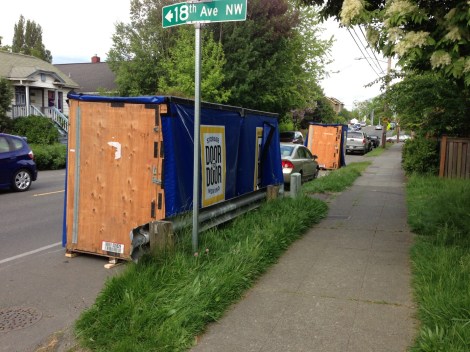
Alan Durning
On-street parking spaces are real estate that belongs to the public. They can be extremely valuable. The land under my house in Seattle is worth more than $38 per square foot, according to the King County Assessor; Zillow implies a value above $45 per square foot. My lot is 50 feet wide. The curb parking area in front of it is therefore 50 feet long; it is about eight feet wide. Were it not for my driveway, three cars could park there. Because of my driveway, two can. It’s 400 square feet of land. If it’s as valuable as my land, at the Assessor’s valuation, it would be worth more than $15,000. Yet the city of Seattle gives away use of this public asset for free. And the city, like all cities, gives it away for only one purpose: storing private motor vehicles. I can keep cars, trucks, or motorcycles there. I cannot keep my bicycles there, though: It would be illegal for me to put a bike rack at my curb and lock my Trek and my Burley bike trailer to it. Walking stroller? No. Granny cart? No. Long board? Razor scooter? Shoe rack? Nope!
My garage is unusual in one way: I am the rare owner of a single-family house in the Northwest who has no private car. But the fact that my garage does not shelter an automobile is not at all unusual. Many garages never do. Garages store stuff, not motor vehicles, much of the time. One detailed, nine-year study of 32 middle-class families in southern California found they had so much stuff in their garages that only one-fourth of them could fit their cars inside.
I asked around among my friends. One neighbor’s two-car garage (pictured below) is like something out of the Storables catalog, and thanks to its masterful engineering, it can still accommodate one small, electric car.
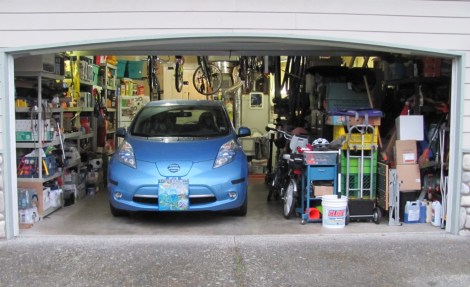
Ron W
Other friends report that their garages are full of exercise equipment, bicycles, lawn mowers and other tools, camping gear, patio furniture, Costco loads, and the occasional ping-pong table. Few keep cars in their garages. Here are excerpts from about 30 friends’ lists of what they keep in their garages:
- a set of half-refinished dining chairs
- one old kitchen sink
- a boat
- boxes and bubble wrap that I might need some day and chickens (until they are big enough to go outside)
- a playroom for my kids
- files that need to be culled through and probably thrown out
- storm windows
- band’s practice space
- old tax records
- books that don’t fit in the house
- toys that will never be used by my family
- a piece of a bowling alley and a wall-size bay window
- last summer’s jams and preserves, family memorabilia, my dad’s chaps from when he broke horses for room and board, his Arctic parka used to survey the North coast of Alaska, my old Royal typewriter and 100 other things
- an old rat cage, leftover wine from the wedding, dried leaves, dust, spider webs
One well-off friend who owns two two-car garages reported that her family still lacks room to keep more than one of its cars inside because the garages hold “boxes of papers, stuffed animals, etc., belonging to daughters, a saddle (it’s for sale!), an antique French food safe that I want to refinish for my grand-daughter’s bedroom, 30 years of crap from our previous house.”
Many garages hold everything but automobiles. Kathleen Ridihalgh of Seattle uses hers for kid stuff and a wood shop (below).

Kathleen Ridihalgh
Paulo Nunes-Ueno, who runs employee transportation programs at Seattle Children’s Hospital, uses his as a bike corral and to store a spare mattress for guests.
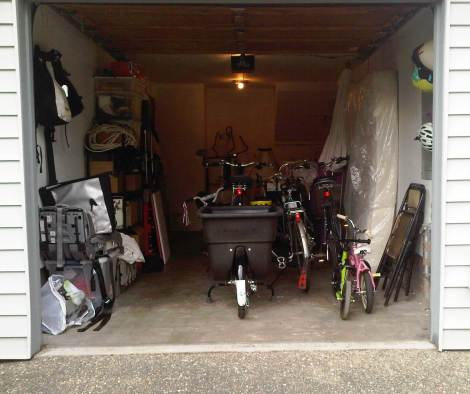
Paulo Nunes-Ueno
Seattle is not alone in requiring one off-street parking space per single-family house. Portland, Vancouver, B.C., and many other cities have the same rule. In fact, virtually every city in greater Portland has this standard, because the regional governing body, Metro, has put a ceiling on parking requirements at one space per house. Most suburban Cascadian cities require two off-street parking spaces per house. Meridian, Idaho, a suburb of Boise, goes further. It requires two spaces for a one-bedroom house, four spaces for a two- to four-bedroom house, and six spaces for a house with five or more bedrooms.
A parking minimum of two (or more) is even worse public policy. Like a one-space minimum, a two-car minimum sometimes yields no net spaces: Many builders planning two-car garages install double-wide driveways, which block two on-street spaces. Worse, as I’ll argue in subsequent articles, off-street mandates tend to glut the market for parking spaces and trigger a chain of cause and effect that ensures massive subsidies to driving. Whatever the number, furthermore, required off-street spaces dramatically push up the minimum cost of building a house. Curb cuts, driveways, and parking spaces cost thousands of dollars. The requirements also result in more pavement getting poured, armoring our watersheds and increasing the quantity of polluted runoff reaching our streams.
Although some cities, such as the Seattle suburb of Beaux Arts, require actual enclosed garages at each single-family house, most cities simply require parking spaces. So I am forbidden to remove the garage in my house unless I provide another off-street parking space on my property in its place. With certain exceptions, this space may not be in front of my house. I cannot just declare the driveway my new parking space. My off-street place must either be inside a garage or beside or behind my house. Many people do, in fact, park their cars in their driveways rather than in their garages. Seattle, at least, allows this manner of parking. But unless the driveways extend beside the house and the car can be positioned beside or behind the house, those parking spaces cannot satisfy land-use code requirements for off-street spaces in Seattle, or in most other cities.
Because my house was built in 1925, long before Seattle imposed a parking minimum, if my house had never included a parking space, I would be grandfathered out of the requirement entirely. But because my house does have a garage, I am not allowed to remove it. Converting my garage to some other purpose would require me to install a new curb cut beside my house, which would be surprisingly expensive, according to a contractor I consulted.
I have lived in my house for 13 years. During those years, my garage has never contained an automobile. In 2002, I installed insulated wall-thick doors on the garage, carpeted it, and began using it as an art room for my kids. Later, it served other purposes, such as an overflow guest room. It is now a computer room, laundry-drying center, and outdoor gear locker (pictured below).
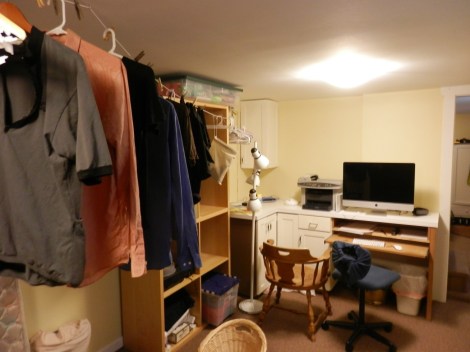
Alan Durning
I am still in compliance with the law. If a city inspector ever asked for evidence of my parking space, I could open the garage doors wide, move the furniture aside, and reveal a fully functional, if carpeted, off-street parking space. The law says I have to have one, not that I need to use it.
Some homeowners take their chances with inspectors. Pictured below is a Seattle house where the garage could no longer hold a car. The owners converted car storage to a sun room, so the property no longer satisfies the parking regs.

Ashley S.
Eliminating one-space-per-dwelling parking requirements for single-family houses would free many other families to do the same, putting their garages and driveways to better uses, improving sidewalk safety, and lowering the construction cost of new houses. Striking out parking standards would let people like me use our property as we wish. My garage doors, thick as they are, still leak heat around the hinges in the winter: in a post-parking rules world, I could replace them with a real wall. I could jackhammer and re-contour the driveway to allow a rain garden. And I could relinquish my curb cut, giving my neighbors an extra place to park.
My garage is a case study in miniature. The fate of the world does not hinge on it. But the ironic, absurd, and pernicious effects of parking rules evident from examining my garage begin to reveal the larger implications of parking standards. I will turn to the larger economy and politics of parking rules next time.
Pam MacRae and Mieko Van Kirk assisted with research for this article. Thanks also to the photographers and friends who shared their garage stories.
Next: A photo essay on parking requirements and the ugly buildings they produce.

